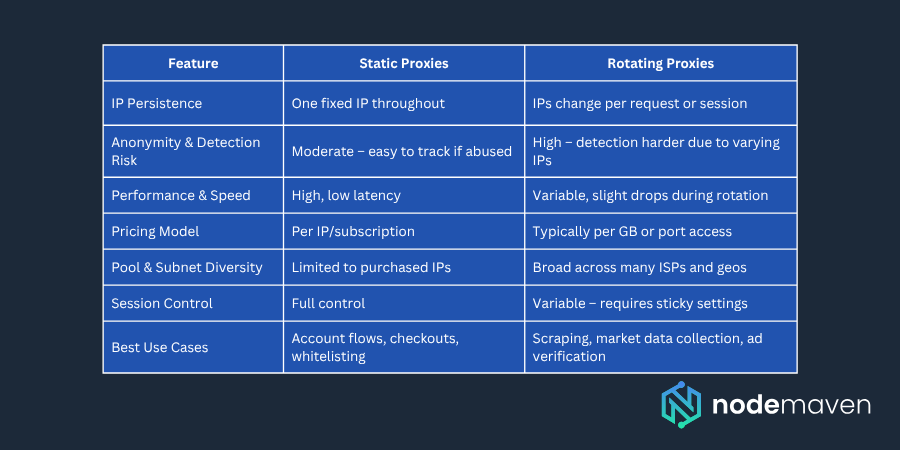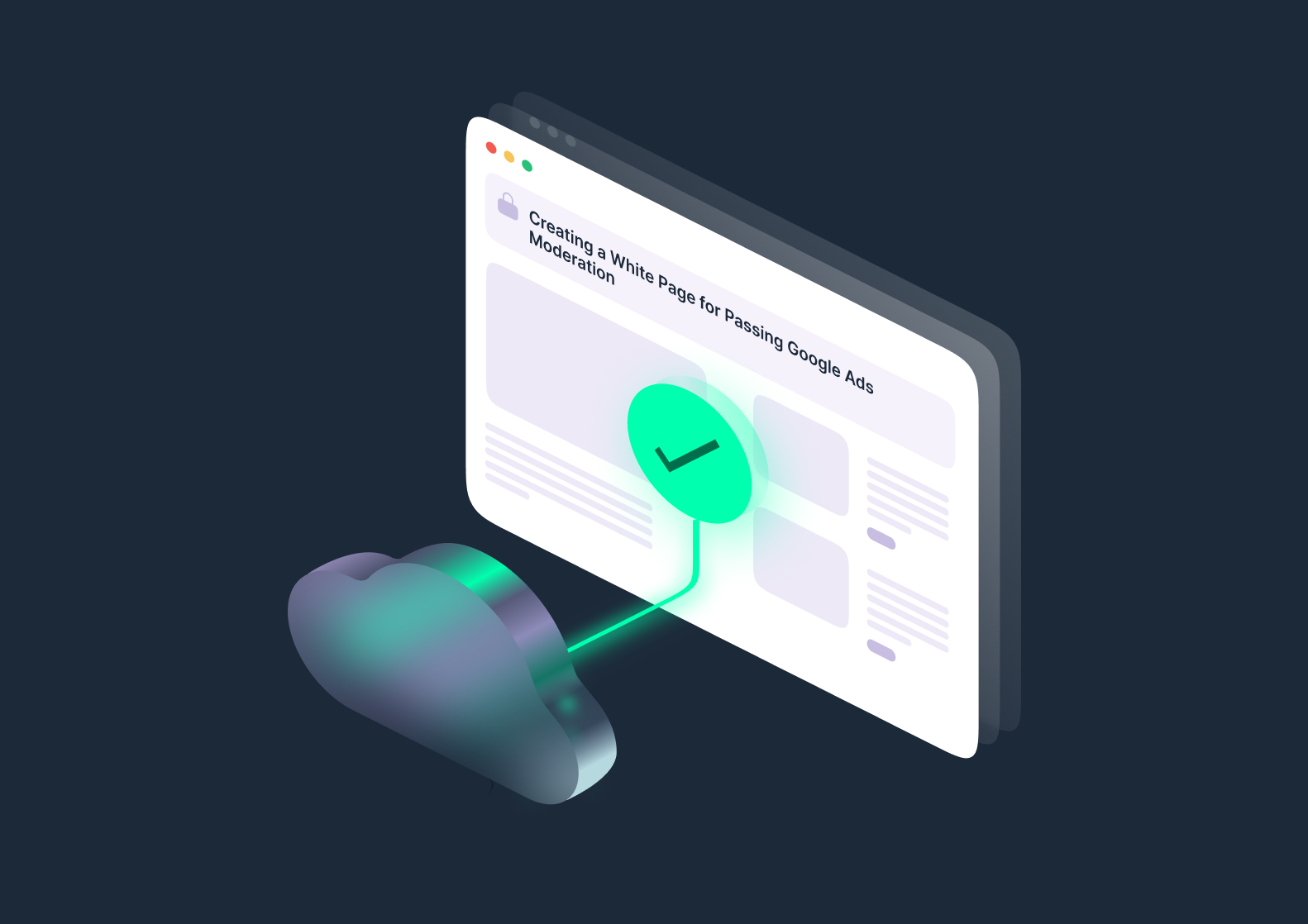Static vs rotating proxies isn’t just a technical comparison, it’s a decision that can make or break your automation, scraping, or ad operations.
Whether you’re running multi-account setups, collecting data at scale, or trying to avoid bans, the type of proxy you use directly impacts your success rate.
In this guide, we’ll break down the differences between static and rotating proxies, explain the best use cases for each, and help you avoid costly mistakes, and how NodeMaven gives you the infrastructure to scale securely with either option.
What Are Static and Rotating Proxies?
Not all proxies behave the same: one sticks, one switches.
Static residential proxies hold a single IP address for the duration of your session. Whether that lasts minutes or months, the IP remains consistent. This approach lends itself to workflows where you need continuity. For example, work requiring whitelists, consistent login sessions, or stable brand presence.
Rotating residential proxies, on the other hand, switch your IP frequently, either automatically after each request or at predetermined intervals. Providers pull from a large IP pool, allowing each request to appear as though it’s coming from a different source. This makes rotating proxies ideal for scraping, large-scale workloads, and avoiding IP fingerprints.
Origins and Evolution
- Static proxies have existed since the dawn of proxy servers. They’re simple, reliable, and unchanged.
- Rotating proxies emerged to address evolving anti-scraping systems and to help users evade dynamic blocking. These are more advanced, used in data aggregation, travel pricing intelligence, and social footprinting.
Now that you understand the basic definitions, let’s dig into the key ways static and rotating proxies behave differently in real-world situations.
Key Differences Between Static vs Rotating Proxies
Let’s break down the practical distinctions that matter most for real-world applications.
1. IP Rotation & Persistence
- Static: You get one IP for the life of the session, affording true continuity, but no masked identity over time.
- Rotating: IPs are automatically changed per request or session, hiding patterns and reducing detectability.
2. Anonymity & Detection Risk
- Static: Ideal when maintaining identity matters, but easier to flag if overused.
- Rotating: You blend into a crowd, great for avoiding blocklists, especially useful for web scraping or data collection.
3. Performance & Speed
- Static: Since no re-routing is required, these proxies often deliver lower latency and better consistency.
- Rotating: There may be slight latency in IP changes, but quality providers optimize to minimize this.
4. Cost Models
- Static: Generally sold per IP, under subscription.
- Rotating: Many providers bill per GB of traffic, with some offering flat-rate access to pools via ports.
5. Pool Size & Subnet Diversity
- Static: Limited and often predictable IPs, less diversity.
- Rotating: Thousands of IPs across subnets and regions, excellent for reaching a wide audience or bypassing geo-blocks.
6. Session Control
- Static: Offers granular control, handy if you need specific geo, ISP, or IP fingerprint.
- Rotating: You can define rotation rules (frequency, sticky sessions), but generally, less predictable.
7. Use Case Fit
- Static: Best for tasks requiring consistent sessions, e-commerce checkouts, social account management, whitelisted pipelines.
- Rotating: Ideal for web scraping, ad verification, SEO intelligence, brand monitoring, or other high-volume operations.
These differences aren’t just technical, they directly influence what you can and can’t do with your proxy setup. To make the right decision, it’s important to weigh the pros and cons next.
Pros and Cons of Static vs Rotating Proxies
Understanding the trade-offs helps you choose wisely:
Static Proxies: Pros & Cons
Pros:
- High stability great for consistent session tasks.
- Low latency and fast throughput.
- Ideal for whitelisted environments and login workflows.
Cons:
- Easy to detect if overused.
- Offers no anonymity or maskability.
- Limited scalability without buying more IPs.
Rotating Proxies: Pros & Cons
Pros:
- High anonymity and low detection footprint.
- Scales effortlessly with large IP pools.
- Great for diverse geo targeting and global data scraping.
Cons:
- Slight delays can occur during rotation.
- Session consistency can suffer without sticky settings.
- Typically costs more on a per-GB basis.
So, when exactly should you use one over the other? Let’s break down real scenarios to see when static or rotating proxies give you the upper hand.
When to Use Static vs Rotating Proxies
Selecting which proxy approach is best depends entirely on what you’re trying to accomplish.
When Static Proxies Shine
- Account-Based Workflows: You’re logging into multiple social accounts, email inboxes, or ad dashboards: session stability is key.
- Transaction Flows: Use cases like e-commerce checkouts, flight bookings, or ticket purchasing, where IP changes mid-process can abort transactions.
- Whitelisted Access: Systems requiring IP whitelisting (e.g., corporate tools, admin panels) depend on a consistent IP.
When Rotating Proxies Are Essential
- Web Scraping at Scale: Collecting data from SERPs, e-commerce platforms, or public APIs without triggering blocks.
- Brand Monitoring & Analytics: Gathering mentions, prices, or ad data across multiple regions, domains, languages.
- Ad Verification: Providing ads load properly across geos and platforms—rotation simulates real user behavior.
Hybrid Approaches
For many operations, a hybrid setup is best:
- Use static proxies for login-bound phases or complex flows requiring persistence.
- Switch to rotating proxies after login, when extracting large data sets or creating high-volume traffic.
If you’re still unsure which direction to go, here are some practical tips to help you make the right call before you spend a dime.
Tips for Choosing Between Static and Rotating Proxies
Here’s how to pick the right setup for your workflow:
- Map Your Workflow Flow: Does it require session persistence? If yes, use static components, otherwise rotating.
- Look for Provider Control: Make sure they allow custom rotation settings, geographic filters, protocol support (HTTP, HTTPS, SOCKS).
- Understand Pricing Models: Check if static IPs or data usage-based pricing suits your budget.
- Test with Pilot Use Cases: Run small-scale tests to measure error rates, detection, speed, and uptime.
- Plan for Scale: Check the size of the IP pool and subnet diversity, critical for scraping or multi-region tasks.
Deep Dive Comparison Table

Still have questions? Let’s clear up some of the most common ones people ask when comparing static vs rotating proxies.
Why NodeMaven Is the Best Choice for Static and Rotating Proxies
If you’re deciding between static vs rotating proxies, the proxy provider you choose matters just as much as the type. NodeMaven offers both with an infrastructure designed for digital hustlers who need performance, stealth, and scale without compromise.
Here’s what makes NodeMaven stand out:
- Premium Residential and Mobile IP Pools
Static and rotating IPs are drawn from real users, not recycled or shared server farms, making them harder to detect and more trusted by platforms. - Smart IP Rotation with Full Session Control
Rotate per request, per time interval, or stick with 24-hour static sessions: perfect for balancing stealth and persistence. - Massive Geo-Targeting Flexibility
Choose proxies by country, city, ASN, or ISP to fine-tune location spoofing or ad testing. - No-Code and Developer-Friendly Integration
Whether you’re using Multilogin, Puppeteer, or headless browsers, NodeMaven proxies plug in easily with CLI, API, or dashboard options. - High Success Rates and Low Ban Frequency
Built-in fingerprint management and proxy health monitoring reduce detection risk, making both static and rotating setups stable and scalable. - Transparent Pricing and Bonus Bandwidth
You get more value per GB, and you can test with lower minimums: perfect for teams scaling campaigns or scraping infrastructure.
Whether you’re managing 50 ad accounts with static IPs or harvesting millions of data points via rotating endpoints, NodeMaven gives you the power and flexibility to run at full throttle.
Frequently Asked Questions (FAQs)
seleniumwire, external proxy APIs, or integrate with services like NodeMaven that support dynamic IP rotation.
- Programmatically, by cycling through a list of proxies in your script.
- Using proxy services that offer automatic rotation by request or time interval.
- Through proxy managers or browsers like Multilogin that integrate rotation at the session level.


